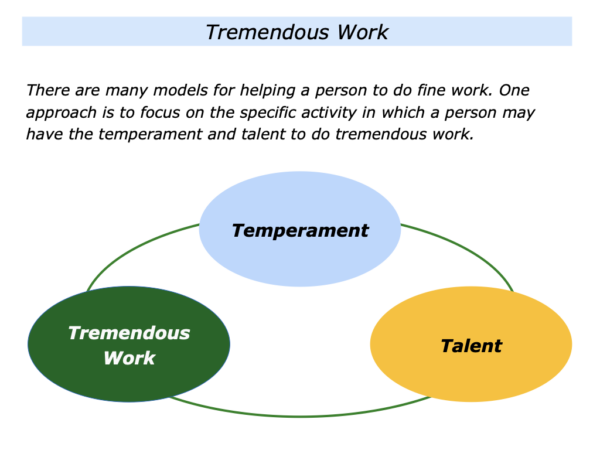
Imagine that a person has asked you to help them to develop in an activity where they may have the ability to do fine work. One approach is to go through the following steps.
You can begin by focusing on the specific activity where they want to do such work. it is then to explore how they can use their temperament and talent to do tremendous work.
There are several definitions for the word tremendous. Here we are using it in terms of a person’s ability to do really good work in a specific activity. Let’s explore how you can help them to take these steps.
Tremendous Work
Imagine that the person wants to do such work. They may want to do this when working as a counsellor, educator, athlete, medic, technical specialist, scientist, leader or in another role.
As mentioned earlier, you can start by clarifying their ability to do work in this area. One approach is to focus on the specific activity they want to pursue. It is then:
To clarify when they have done really good work this specific activity in the past;
To clarify the principles they followed then – and how they translated these into action – to do really good work;
To clarify how they may be able to follow these principles to do really good work in the future.
Imagine that you have explored these themes with the person. This may have revealed that they may have the ability to do really good work in a specific activity.
There may also be additional reasons why they have the ability to do such work. The person may, for example, have the drive to keep improving and the desire to perform at their best.
If appropriate, you may want to do the following exercise. This invites you to write the person’s name and then to describe:
The specific activity in which they want to do tremendous work;
The specific reasons why they may be able to do such work in this activity.
Here is the exercise on this theme.
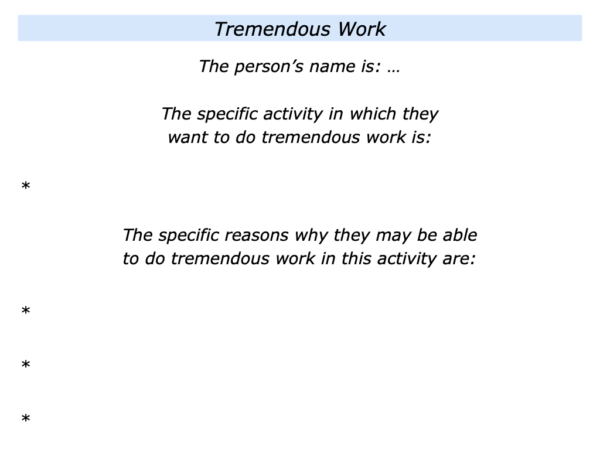
What happens if the person may not appear to be able to do such work? One approach is for them to opt to simply aim to make the most of their ability.
Another approach is for them to focus on another specific activity where: a) they have the ability to superb work; b) they will find such work satisfying; c) they can deliver success.
Imagine, however, that the person does have the ability to do tremendous work in their chosen activity. It can then be time to move on to the following theme.
Temperament
Great workers have the temperament required to do their chosen work. Looking at the person you are helping, what may be the kind of temperament they need to demonstrate to deliver top performances?
Different kinds of work require different temperaments. A paramedic needs to be calm in distressing situations. A salesperson needs to be motivated and resilient. An athlete needs to manage pressure and rise to the occasion.
If a person wants to lead an organisation, for example, this calls for having a certain kind of personality. It involves being prepared to accept the pluses and minuses involved in the role. Here are some of the upsides and downsides when running an organisation.
The pluses may include being able:
To clarify and communicate the organisation’s purpose, principles and picture of success;
To create a positive culture in which motived people can grow and deliver success;
To earn a good salary and grow as a person;
To enjoy the adrenaline and excitement involved in leading an organisation;
To make sure the organisation keeps delivering today’s business whilst also building tomorrow’s business in order to achieve ongoing success.
The potential minuses may include:
To sometimes feel lonely because nobody else may be privy to the implications of the decisions you are making;
To make decisions that have implications for all the stakeholders – the owners, employees, customers and society;
To proactively manage the key stakeholders – such as head office – to keep them satisfied and stop them interfering;
To perhaps work a minimum of 12 hours a day plus weekends;
To get cut off from the reality of what is happening on the ground – particularly what is happening for customers – and therefore make poorer decisions.
Let’s return to the person who may want to develop. Bearing in mind the activity they want to pursue, what is the temperament they need to demonstrate to deliver tremendous work?
On a scale 0-10, how would you rate them in terms of demonstrating these qualities? What can they do to maintain or improve the rating?
If you wish, try tackling the exercise on this theme. This invites you to complete the following sentences.
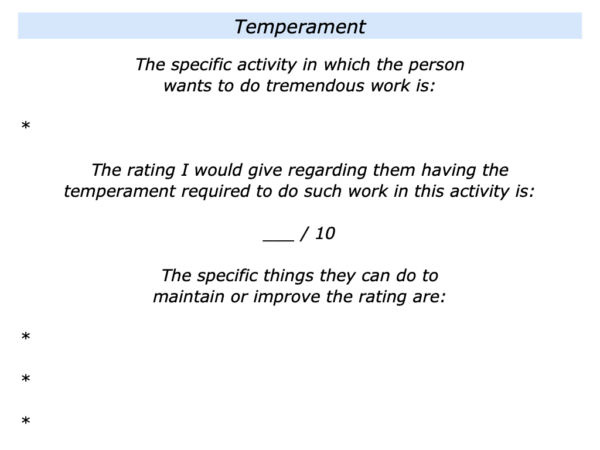
Talent
Talent is a prerequisite for doing great work. A therapist needs to combine caring with being able to clarify a person’s aims and achieve their goals. A general practitioner needs medical skills, people skills and, in some cases, organisational skills to run a good practice.
A leader needs to make good decisions. They need to implement the right strategy with the right people in the right way. They also need to build a positive culture in which motivated people do superb work.
A footballer needs certain skills to play in a specific position. The Ajax football club has a great track record for producing young players. It uses the Acronym TIPS when looking at a player’s development.
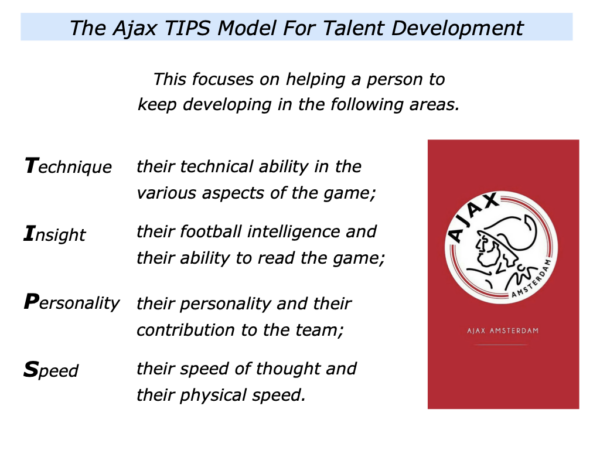
Let’s return to the person you are helping to develop in their chosen activity. You may have already explored when they have demonstrated some of these talents.
If appropriate, however, you may wish to list the talents required to deliver tremendous work in the specific activity. You can then focus on, for example, the key talents they will need to demonstrate.
Imagine that you have taken this step. If you wish, you can then try tackling the exercise on this theme. This invites you to complete the following sentences.
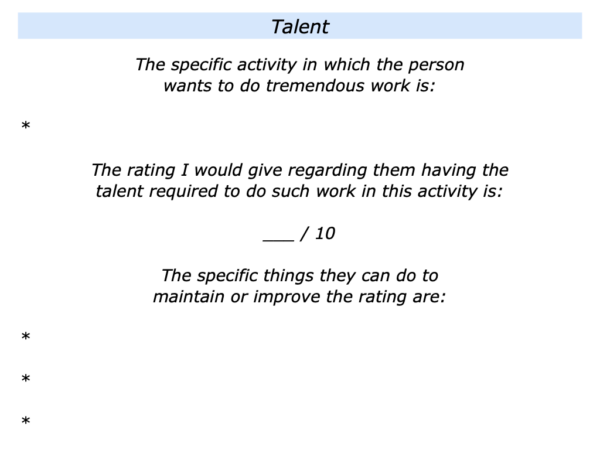
Tremendous Work
Temperament and talent can take a person so far. They may then also need to apply the right tactics and tenacity to do tremendous work. Let’s explore these themes.
Tactics
Great workers clarify the strategies most likely to deliver success. They then clarify the specific actions they will take to implement the strategies and perform tremendous work.
Here we are using the term tactics to include both the strategic elements and the specific actions. Depending on their work, different people will adopt this approach in different ways.
Great workers often make good strategic decisions about the specific activity they will pursue. They put themselves into a place where they can play to their strengths and do superb work. They then do their best to deliver success.
Good sports coaches build on their team’s strengths. They educate their players to follow certain strategies and achieve routine perfection. They then translate these into specific tactics which the players can implement to achieve success.
Let’s return to the person you may be helping to develop. How would you rate them in terms of demonstrating the required tactics? This includes good strategic thinking and translating these strategies into action. What can they do to maintain or improve the rating?
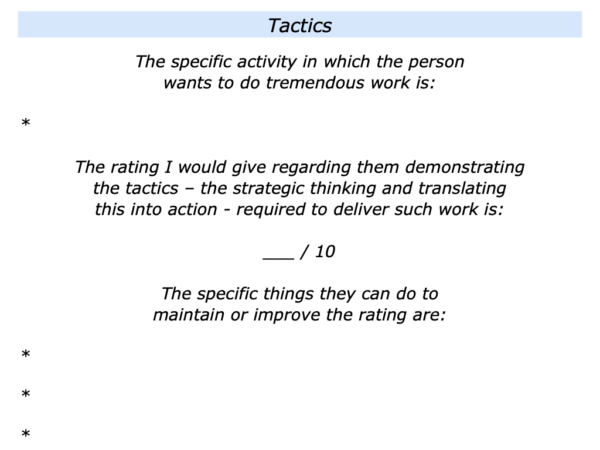
Tenacity
Great workers demonstrate tenacity. They may do this when aiming to develop a skill, continue to improve or overcome challenges to reach a goal.
Such people show grit, persistence and resilience. They put in the effort required to improve their mentality and technique on the way to doing tremendous work. Let’s look at one example.
Wayne Gretzky, the great ice hockey player, described how he took this route. Talking with Michael Murphy for the book In The Zone, he explained how he practiced during his childhood.
“I’d get up in the morning, skate from 7.00 to 8.30, go to school, come home at 3.30, stay on the ice until my mom insisted I come in for dinner, eat in my skates and then go back out until 9.00.
“On Saturdays and Sundays, we’d have huge games, but night time became my time. It was sort of an unwritten rule around the neighbourhood that I would be out there by myself or with my dad.
“I would just handle the puck in and out of those empty detergent bottles my dad set up as pylons. Then I’d set up targets in the net and try to hit them with forehands, backhands, whatever. Then I’d do it all again, except this time with a tennis ball, which is much harder to handle.
“I was so addicted that my dad had big kids come over to play against me. When the kids wanted to go home, I’d beg them to stay longer.”
Great workers see every day as an opportunity to improve. Sometimes this involves demonstrating tenacity – persistence and determination to reach a specific goal.
Let’s return to the person you may be helping to develop. How would you rate them in terms of demonstrating tenacity? What can they do to maintain or improve the rating? If you wish, try tackling the exercise on this theme. This invites you to complete the following sentences.
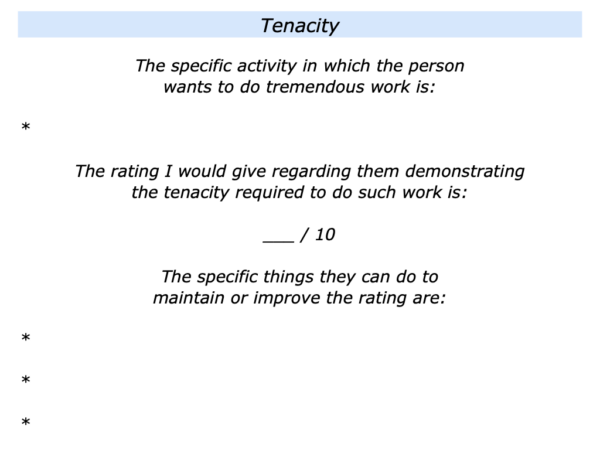
Tremendous Work
Great workers aim to do their best to perform tremendous work. Different people do this in different ways. Some take the following steps when applying their abilities.
They Trust Their Talent
Such workers often aim to relax and trust their talent. It sounds like a paradox, but they work hard at being able to relax. This enables them to make better use of their strengths when doing the work.
They Trust Their Tactics
They aim to trust their tactics – which includes both physical and psychological preparation. They rehearse following their strategies and tactics. This gives them something to fall back on when necessary.
They Trust Their Technique
Great workers hone their technique and aim to trust it in certain situations. They take this approach rather than becoming tense. They are then more able to flow and deliver top performances.
Christian Horner, Principal of the Red Bull Formula 1 Team, described how he wanted one of his drivers to take this approach. Here is a summary of what he said.
“This driver is extremely talented, but sometimes he crams too much information into his head. He needs to prepare properly but then let his instinct take over.
“Great drivers have that edge. They rehearse the race ahead of time and then apply their natural flair to perform superbly at critical moments.”
Great workers spend years building on their strengths and developing skills for managing their weaknesses. Preparing thoroughly, they clarify their strategies for dealing with many different situations.
They take these steps whether they are playing a sport, acting on stage, climbing a mountain or doing some other activity. Being fully prepared, they are able to apply their skills and achieve success.
On some occasions, however, they may hit a block. They over-think things, try too hard or tighten up in stressful situations. They may become over-critical and get into a downwards spiral. Top performers may then follow their chosen ritual to calm themselves.
Matt Lloyd, the climber and writer, explores this approach in an article he wrote called The Mind Game: How To Overcome Fear. He begins the article by referring to a near-death experience he had when climbing.
Matt recalls how dealing with it called for staying calm, doing the basics and then trusting his technique. He then describes some of the tools he learned for managing fear.
Be Prepared
When you’re prepared and well-practiced, you have no reason to doubt yourself. It’s not about closing your eyes and jumping into the unknown.
It’s about having eyes wide open to the dangers around you but knowing that you’re as ready as you can be. Trust in your training and preparedness will give you the required confidence to apply your skills to the task at hand.
While performing, the pros work consciously and in the current moment. They focus on the task at hand rather than the outcome, staying present rather than thinking too far into the event or about the finish.
Matt then builds on some of the ideas he learned from Lisa Lollar, a sports psychologist.
Visualization
Use this as much as you can before you even get off the ground, while lying in bed at night or driving to the crag. The basic idea is to imagine and clearly see yourself completing each move with ease. Go through each move step by step from bottom to top.
Centering
Best done right after coming out of the initial fear flood, it involves paying conscious attention to breathing and bodily sensations. Centering helps the athlete stay in the moment and release past and future thoughts, worries, and plans.
Self-Talk
Use this at any time to quiet the amygdala, awaken the prefrontal cortex, and regain your calm. Either out loud or in your head, talk to yourself. Make it simple: “I’m fine” or “I can do this” or “I got it.”
On a recent 5.11 free solo in Golden, Colorado, I sat at the bottom of the climb thinking about how quickly panic sets in. I then imagined myself handling that experience calmly, breathing deeply, and saying to myself, Relax, you can do this.
I still get scared – hell, what climber doesn’t? – but now I’m better equipped to keep my cool, and that’s made all the difference.
Great workers may start by doing small pieces of fine work. They then aim to follow good habits and keep improving. This can lead to them maintaining high standards and consistently delivering tremendous work.
Let’s return to the person you may be helping. How would you rate their present performance regarding consistently delivering such work? What can they do to maintain or improve the rating? How can you help them to take this step?
If you wish, try tackling the final exercise on this theme. This invites you to complete the following sentences.
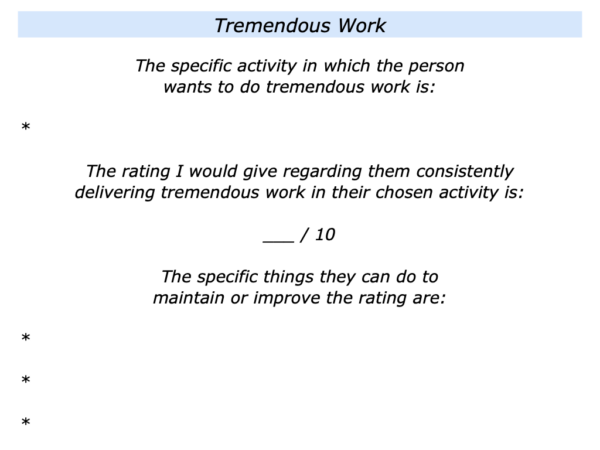






Leave a Reply